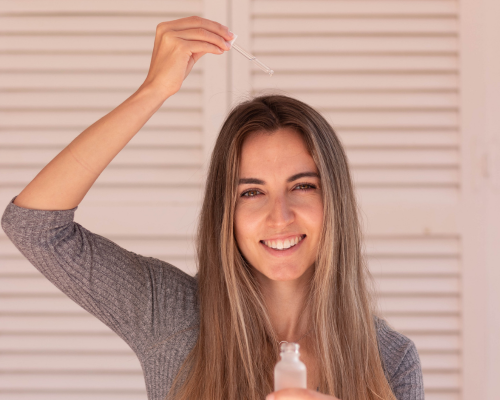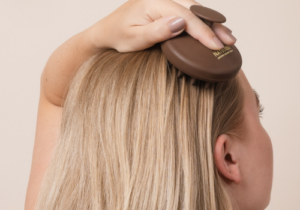Introduction to scalp massage to promote hair growth
Have you ever wished your hair would grow faster and healthier? Scalp massage could be one of the most effective natural solutions. Massaging this area can not only offer a moment of relaxation, but also stimulate hair growth. It's a simple technique that's accessible to everyone, and is gaining in popularity thanks to its proven benefits for hair and scalp health. hair growth.
Understanding the importance of scalp massage for hair growth
The scalp plays an essential role in the overall health of our hair. It's important to understand how a simple massage can contribute to longer, stronger locks.
Role of the scalp in hair growth
The scalp is made up of living tissue that requires good blood circulation to nourish the hair follicles. Each hair follicle benefits from the supply of oxygen and nutrients via the network of subcutaneous blood vessels. Insufficient blood circulation can lead to slower hair growth and even hair loss.
How does scalp massage stimulate hair growth?
Scalp massage stimulates blood circulation, which means more nutrients and oxygen reach the hair follicles. This improved blood circulation contributes to healthier hair by promoting faster growth. What's more, scalp massage can help remove traces of dirt and oil that clog follicles, enabling optimal hair growth.
Regular use of this technique also has a psychological impact. Stress is often linked to hair loss, and a relaxing massage can reduce stress, indirectly improving hair health.
Preparing the scalp for massage
Preparing the scalp before a massage is an essential step that can amplify the effectiveness of this practice. Before you begin, it's crucial to know your scalp type so you can choose the right methods and products to derive maximum benefit.
Identifying your scalp type
Everyone has a different type of scalp, and each type has its own specific needs. Understanding the characteristics of your scalp will help you select the right oils and massage techniques.
Dry scalp
- Signs: Frequent itching, dry dandruff, feeling of tightness.
- Causes: Lack of sebum, cold climates, excessive use of aggressive hair care products.
- Preparation solutions: Hydration and nutrition are essential. Use nourishing oils and avoid frequent washing to preserve the scalp's natural oils.
Oily scalp
- Signs: rapidly greasy hair, heaviness, greasy dandruff.
- Causes: Overproduction of sebum, hormonal imbalance, inappropriate hair care.
- Preparation solutions: Choose light oils that help regulate sebum production, and opt for purifying shampoos.
Choosing the right oil for scalp massage
Oils play a key role in the effectiveness of scalp massage. Not only do they provide hair with essential nutrients, but they also act on the texture and hydration of the scalp.
Using jojoba oil for dry scalps
- Properties: Jojoba oil is known for its ability to mimic human sebum. It deeply moisturizes without leaving a greasy residue.
- Benefits: Nourishes and repairs dry hair, reduces itching and promotes a healthier scalp.
- Application tips: Warm the oil slightly before applying with a gentle massage to maximize absorption.
Using tea tree oil for oily scalps
- Properties: Tea tree oil has antiseptic and antifungal properties that help purify the scalp.
- Benefits: Balances sebum production, reduces dandruff and refreshes the scalp.
- Application tips: Mix a few drops of tea tree oil with a carrier oil such as jojoba, then massage gently to avoid irritation.
By identifying your scalp type and choosing the right oils, you lay the foundations for an effective scalp massage. This not only helps to improve the health of your hair, but also prepares your mind and body for ultimate relaxation during the massage.
See also: How to limit stress-related hair loss?
Scalp massage techniques to promote hair growth
Once you've prepared your scalp and chosen the right oil, it's time for the crucial step: massage. Although it may seem simple, having the right massage technique can make a big difference in maximizing the stimulation of hair growth.
Step-by-step scalp massage
Performing an effective scalp massage requires a methodical, caring approach. Here's a step-by-step guide to make sure you get the most out of every massage session:
Apply oil to scalp
- Start by dividing your hair into sections to facilitate even application of the oil.
- Pour a small amount of oil into the palm of your hand and rub your palms together to warm it slightly.
- Apply the oil directly to the scalp using your fingertips, avoiding too much on the lengths to weigh them down.
- Concentrate on the scalp, which will benefit most from the oil's nourishing properties.
Circular massage technique
- Use your fingertips, not your fingernails, to apply pressure.
- Start at the nape of the neck and initiate light, gentle circular movements.
- Slowly work your way up to the top of the head, ensuring that each area receives the same level of attention and care.
- Reduce pressure if you feel discomfort, as the massage should be relaxing and not painful.
Focus on pressure points
- Take time to massage the temples, an area often overlooked but important for overall relaxation.
- Apply gentle pressure and concentrate on circular movements, as these areas contain pressure points that can release accumulated tension.
Massage frequency and duration
To really reap the benefits of scalp massage, consistency and duration are key.
- Frequency: Ideally, massage at least 2-3 times a week. However, listen to your scalp and adjust according to its reaction.
- Duration: The average duration of an effective massage should be around 5 to 10 minutes. This ensures that you stimulate the scalp sufficiently without irritating it.
Tips for Optimizing Scalp Massage
Some tips can help you optimize your massage routine for even better results:
- Adjust the technique to your comfort level and avoid rubbing too vigorously to prevent damage to hair fibers.
- Mix your oil with essential oils such as lavender or rosemary for additional effects such as soothing or anti-dandruff properties.
- Remember to practice relaxation or deep-breathing exercises before your massages to amplify the anti-stress benefits.
By following these techniques and tips, you'll maximize the benefits of a scalp massage, while creating an environment conducive to healthy, rapid hair growth.
Additional benefits of scalp massage
Improved hair texture
In addition to promoting hair growth, scalp massage can also improve hair texture. By stimulating the production of natural oils, this type of massage helps to make hair softer and shinier. The even distribution of these natural oils through massage prevents greasy roots and dry ends, providing an even, healthy hair texture.
Stress reduction
Stress is a major factor contributing to hair loss. A scalp massage not only stimulates hair growth, it can also serve as an effective means of reducing stress. Gentle, circular movements of the fingertips activate the nerve endings in the scalp, providing immediate relaxation.
Overall improvement in hair health
With regular practice, scalp massage can also strengthen roots and make hair more resistant to external aggressors such as pollution, heat and chemicals. It also deeply cleanses the scalp, contributing to better absorption of beneficial hair care products.
Elimination of toxins
Massages stimulate lymphatic circulation, enabling the slow elimination of toxins from the scalp. This contributes not only to scalp health, but also to that of the whole body, promoting a general sense of well-being.
FAQ section
How often should I massage my scalp for best results?
It is generally recommended to massage the scalp 2-3 times a week for optimal results. This allows your scalp to rest between sessions while stimulating growth consistently.
How long should each massage session last?
Each scalp massage session should ideally last between 5 and 10 minutes. This ensures that the massage is long enough to stimulate the scalp without stressing it.
Which oils are most effective for scalp massage?
Oils such as jojoba oil and tea tree oil are particularly effective for scalp massage, due to their moisturizing and sebum-balancing properties. Other oils, such as lavender or rosemary oil, can also be beneficial.
Do I need to wash my hair after each massage?
You don't need to wash your hair after each massage, unless your hair has become excessively oily. However, do wash your hair if you feel that the oil residue is too much for your comfort.
Are scalp massages suitable for all hair types?
Yes, scalp massages are suitable for all hair types. The key is to adapt the pressure and products used (such as oils) to the specific needs of your scalp and hair.




